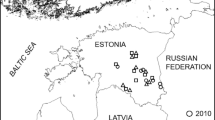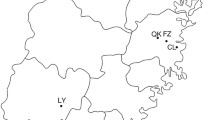Abstract
Changes in pathotype frequencies due to sexual reproduction during summer were assessed in barley plots inoculated at the start of the growing season with powdery mildew isolates of the pathotype GL1 (Va22Vh) which belonged to a clonal lineage frequent in Northern France in 1992–1996 and was absent or rare in the local population at the time of the study. The capacity for recombination among isolates belonging to the pathotype GL1 was confirmed by performing crosses in the greenhouse. The field experiment was repeated over two years, with two field plots inoculated with either a single isolate (one mating type) or four isolates (two mating types). Following artificial inoculation, the frequency of GL1 increased to between 40% and 80% of the total conidia population at the end of the asexual epidemics before summer. When only one isolate (one mating type) of the pathotype GL1 was present, the frequency of the GL1 pathotype decreased to 4–5% of the ascospore population, following sexual recombination between the inoculated isolate and the local natural population. When isolates of both mating types of GL1 were inoculated, however, the GL1 pathotype remained dominant (28%) in the ascospore population. A pathotype dominant at the end of the summer might possibly have over-summered through asexual reproduction, or alternatively it may originate from sexual reproduction. The observed GL1 frequencies and numbers of virulences per isolate (complexity) observed on the field plots were compared to those calculated with a model assuming random or non-random mating.
Similar content being viewed by others
References
Andrivon D and de Vallavieille-Pope C (1993) Racial diversity and complexity in regional populations of Erysiphe graminis f. sp. hordei in France over a 5-year period. Plant Pathology 42: 443-464
Brändle UE (1994) Studies on the genetic structure of local populations of Erysiphe graminis f. sp. hordei Marchal. Ph.D. Thesis. Swiss Federal Institute of Technology, Switzerland, Zurich
Brändle UE, Haemmerli UA, McDermott JM and Wolfe MS (1997) Interpreting population genetic data with the help of genetic linkage maps. In: Crute IR, Holub EB and Burdon JJ (eds) The Gene-for-Gene Relationship in Host-Parasite Interactions (pp 157-171) CAB International, Oxon
Brown JKM (2000) Estimation of rates of recombination and migration in populations of plant pathogens. Phytopathology 90: 320-323
Brown JKM and Wolfe MS (1990) Structure and evolution of a population of Erysiphe graminis f. sp. hordei. Plant Pathology 39: 376-390
Brown JKM and Simpson CG (1994) Genetic analysis of DNA fingerprints and virulences in Erysiphe graminis f. sp. hordei. Current Genetics 26: 172-178
Brown JKM, Jessop AC, Thomas S and Rezanoor HN (1992) Genetic control of the response of Erysiphe graminis f. sp. hordei to ethirimol and triadimenol. Plant Pathology 41: 126-135
Brown JKM, Le Boulaire S and Evans N (1996) Genetics of responses to morpholine-type fungicides and of avirulences in Erysiphe graminis f. sp. hordei. European Journal of Plant Pathology 102: 479-490
Brown JKM, Foster EM and O'Hara RB (1997) Adaptation of powdery mildew populations to cereal varieties in relation to durable and non-durable resistance. In: Crute IR, Holub EB and Burdon JJ (eds) The Gene-for-Gene Relationship in Host-Parasite Interactions (pp 119-138) CAB International, Oxon
Caffier V, Hoffstadt T, Leconte M and de Vallavieille-Pope C (1996a) Seasonal changes in pathotype complexity in French populations of barley powdery mildew. Plant Pathology 45: 454-468
Caffier V, de Vallavieille-Pope C and Brown JKM (1996b) Segregation of avirulences and genetic basis of infection types in Erysiphe graminis f. sp. hordei. Phytopathology 86: 1112-1121
Caffier V, Brändle U and Wolfe MS (1999) Genotypic diversity in barley powdery mildew populations in northern France. Plant Pathology 48: 582-587
Goodwin SB, Spielman LJ, Matuszak JM, Bergeron SN and Fry WE (1992) Clonal diversity and genetic differentiation of Phytophthora infestans populations in northern and central Mexico. Phytopathology 82: 955-961
Goodwin SB, Smart CD, Sandrock RW, Deahl KL, Punja JK and Fry WE (1998) Genetic change within populations of Phytophthora infestans in the United States and Canada during 1994 to 1996: Role of migration and recombination. Phytopathology 88: 939-949
Göz M, Friedrich S and Boyle C (1996) Development of cleistothecia and early ascospore release of Erysiphe graminis DC. f. sp. tritici in winter wheat in relation to host age and climatic conditions. Zeitschrift f¨ur Pflanzenkrankheiten und Pflanzenschutz 103: 134-141
Groth JV and Roelfs AP (1982). The effect of sexual and asexual reproduction on race abundance in cereal rust fungus populations. Phytopathology 72: 1503-1507
Jørgensen JH (1988) Erysiphe graminis, powdery mildew of cereals and grasses. Advances in Plant Pathology 6: 137-157
Koenig RL, Ploetz RC and Kistler HC (1997) Fusarium oxysporum f. sp. cubense consists of a small number of divergent and globally distributed clonal lineages. Phytopathology 87: 915-923
Kølster P, Munk L, Stølen O and Løhde J (1986) Near-isogenic barley lines with genes for resistance to powdery mildew. Crop Science 26: 903-907
Moseman JG, Macer RCF and Greeley LW (1965) Genetic studies with cultures of Erysiphe graminis f. sp. hordei virulent on Hordeum spontaneum. Transactions of the British Mycological Society 48: 479-489
Müller KE, McDermott JM, Wolfe MS and Limpert E (1996) Analysis of diversity in populations of plant pathogens: The barley powdery mildew pathogen across Europe. European Journal of Plant Pathology 102: 385-395
Smedegård-Petersen V (1967) Studies on Erysiphe graminis DC with a special view to the importance of the perithecia for attacks on barley and wheat in Denmark. Kønglisk Veterinaerog Landbohøjskoles Årsskrift 1967: 1-28
Wellings CR and McIntosh RA (1990) Puccinia striiformis f. sp. tritici in Australasia: Pathogenic changes during the first 10 years. Plant Pathology 39: 316-325
Welz G and Kranz J (1987) Effects of recombination on races of a barley powdery mildew population. Plant Pathology 36: 107-113
Wolfe MS and McDermott JM (1994) Population genetics of plant pathogen interactions: The example of the Erysiphe graminis-Hordeum vulgare pathosystem. Annual Review of Phytopathology 32: 89-113
Wolfe MS, Bräandle U, Koller B, Limpert E, McDermott JM, Müller K and Schaffner D (1992) Barley mildew in Europe: Population biology and host resistance. Euphytica 63: 125-139
Zeigler RS (1998) Recombination in Magnaporthe grisea. Annual Review of Phytopathology 36: 249-275
Zhan J, Mundt CC and McDonald BA (1998) Measuring immigration and sexual reproduction in field populations of Mycosphaerella graminicola. Phytopathology 88: 1330-1337
Zhan J, Mundt CC and McDonald BA (2000) Estimation of rates of recombination and migration in populations of plant pathogens-a reply. Phytopathology 90: 324-326
Author information
Authors and Affiliations
Rights and permissions
About this article
Cite this article
Bousset, L., de Vallavieille-Pope, C. Effect of Sexual Recombination on Pathotype Frequencies in Barley Powdery Mildew Populations of Artificially Inoculated Field Plots. European Journal of Plant Pathology 109, 13–24 (2003). https://doi.org/10.1023/A:1022034829401
Issue Date:
DOI: https://doi.org/10.1023/A:1022034829401




